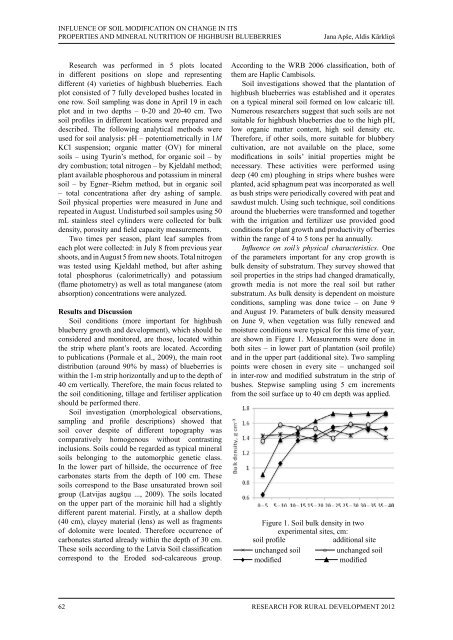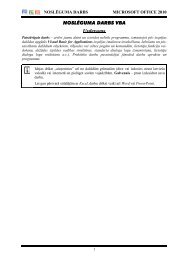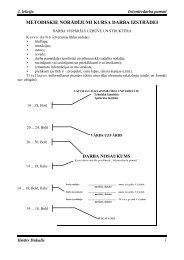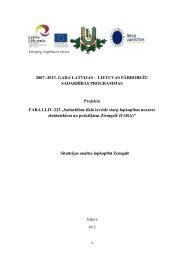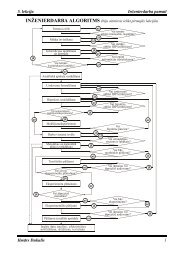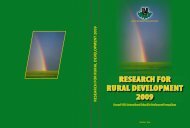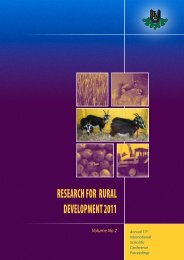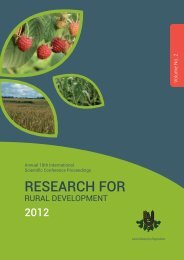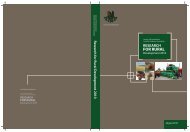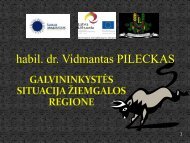LATVIA UNIVERSITY OF AGRICULTURE - Latvijas ...
LATVIA UNIVERSITY OF AGRICULTURE - Latvijas ...
LATVIA UNIVERSITY OF AGRICULTURE - Latvijas ...
- No tags were found...
Create successful ePaper yourself
Turn your PDF publications into a flip-book with our unique Google optimized e-Paper software.
INFLUENCE <strong>OF</strong> SOIL MODIFICATION ON CHANGE IN ITSPROPERTIES AND MINERAL NUTRITION <strong>OF</strong> HIGHBUSH BLUEBERRIESJana Apše, Aldis KārkliņšResearch was performed in 5 plots locatedin different positions on slope and representingdifferent (4) varieties of highbush blueberries. Eachplot consisted of 7 fully developed bushes located inone row. Soil sampling was done in April 19 in eachplot and in two depths – 0-20 and 20-40 cm. Twosoil profiles in different locations were prepared anddescribed. The following analytical methods wereused for soil analysis: pH – potentiometrically in 1MKCl suspension; organic matter (OV) for mineralsoils – using Tyurin’s method, for organic soil – bydry combustion; total nitrogen – by Kjeldahl method;plant available phosphorous and potassium in mineralsoil – by Egner–Riehm method, but in organic soil– total concentrationa after dry ashing of sample.Soil physical properties were measured in June andrepeated in August. Undisturbed soil samples using 50mL stainless steel cylinders were collected for bulkdensity, porosity and field capacity measurements.Two times per season, plant leaf samples fromeach plot were collected: in July 8 from previous yearshoots, and in August 5 from new shoots. Total nitrogenwas tested using Kjeldahl method, but after ashingtotal phosphorus (calorimetrically) and potassium(flame photometry) as well as total manganese (atomabsorption) concentrations were analyzed.Results and DiscussionSoil conditions (more important for highbushblueberry growth and development), which should beconsidered and monitored, are those, located withinthe strip where plant’s roots are located. Accordingto publications (Pormale et al., 2009), the main rootdistribution (around 90% by mass) of blueberries iswithin the 1-m strip horizontally and up to the depth of40 cm vertically. Therefore, the main focus related tothe soil conditioning, tillage and fertiliser applicationshould be performed there.Soil investigation (morphological observations,sampling and profile descriptions) showed thatsoil cover despite of different topography wascomparatively homogenous without contrastinginclusions. Soils could be regarded as typical mineralsoils belonging to the automorphic genetic class.In the lower part of hillside, the occurrence of freecarbonates starts from the depth of 100 cm. Thesesoils correspond to the Base unsaturated brown soilgroup (<strong>Latvijas</strong> augšņu ..., 2009). The soils locatedon the upper part of the morainic hill had a slightlydifferent parent material. Firstly, at a shallow depth(40 cm), clayey material (lens) as well as fragmentsof dolomite were located. Therefore occurrence ofcarbonates started already within the depth of 30 cm.These soils according to the Latvia Soil classificationcorrespond to the Eroded sod-calcareous group.According to the WRB 2006 classification, both ofthem are Haplic Cambisols.Soil investigations showed that the plantation ofhighbush blueberries was established and it operateson a typical mineral soil formed on low calcaric till.Numerous researchers suggest that such soils are notsuitable for highbush blueberries due to the high pH,low organic matter content, high soil density etc.Therefore, if other soils, more suitable for blubberycultivation, are not available on the place, somemodifications in soils’ initial properties might benecessary. These activities were performed usingdeep (40 cm) ploughing in strips where bushes wereplanted, acid sphagnum peat was incorporated as wellas bush strips were periodically covered with peat andsawdust mulch. Using such technique, soil conditionsaround the blueberries were transformed and togetherwith the irrigation and fertilizer use provided goodconditions for plant growth and productivity of berrieswithin the range of 4 to 5 tons per ha annually.Influence on soil’s physical characteristics. Oneof the parameters important for any crop growth isbulk density of substratum. They survey showed thatsoil properties in the strips had changed dramatically,growth media is not more the real soil but rathersubstratum. As bulk density is dependent on moistureconditions, sampling was done twice – on June 9and August 19. Parameters of bulk density measuredon June 9, when vegetation was fully renewed andmoisture conditions were typical for this time of year,are shown in Figure 1. Measurements were done inboth sites – in lower part of plantation (soil profile)and in the upper part (additional site). Two samplingpoints were chosen in every site – unchanged soilin inter-row and modified substratum in the strip ofbushes. Stepwise sampling using 5 cm incrementsfrom the soil surface up to 40 cm depth was applied.Figure 1. Soil bulk density in twoexperimental sites, cm:soil profileadditional site× unchanged soil ○ unchanged soil♦ modified ▲ modified62 Research for Rural Development 2012


